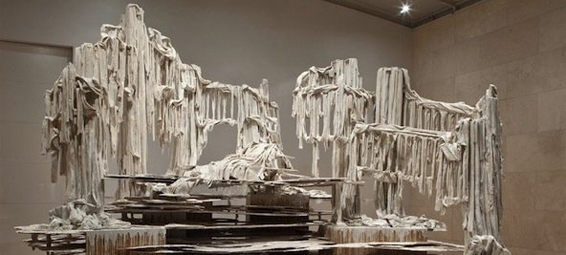In the latest Sightings installation at the Nasher, New York-based, Syrian-born, and Ohio-raised artist Diana Al-Hadid takes over a room facing Flora St. with her multi-faceted, theatrical sculpture. Formal and liquid, amorphous and figurative, Al-Hadid’s work explores notions of traditional architecture while adapting elements of painting, stagecraft, and suggestive, open-ended narratives. While her work can sometimes look like renderings from a fantasy world, the pieces are as much intricate studies of space and structure in which the viewer is continually reengaging the work through the constant shift and flow of perspectives. I spoke to Al-Hadid about how her newer work is making deliberate strides to distance itself from the more “scripted” (her word) elements of her previous sculpture.
FrontRow: The room your piece is installed in is very important to the work in so far as it creates a kind of theatrical setting for the art and interplays with the exterior of the museum – the street – through the large front window. Did you choose that room specifically?
Diana Al-Hadid: It’s been the room they have been using, and they suggested it. It is nice to have a limitation. It gives me some parameters. I liked that it was its own space. I’m a little greedy about that stuff sometimes. It depends what’s there. It is nice to have clean sightlines, especially on this piece. On all my pieces you see through them. Unlike the [Tony] Cragg pieces [on view in the neighboring gallery at the Nasher] they are not discrete, whole objects. So I’m fussing over those little sightlines pretty manically. So it is nice to be alone in that room.
FR: You’re work also works with the architecture of Renzo Piano’s space and its own references to classical architecture: columns and arches. Did you have the building in mind as you conceived of and executed this piece?
DA: It was that and the arch. I don’t think there are columns in there, but the arch is nice because it does feel like a stage.
FR: You’re work is very architectural in terms of structure, but then it also contains references to historical objects and periods and there’s a sense of fantasy as well. For this piece, did you start with a preconceived image or a something specific? Where is your launching point?
DA: I really start with what I know for sure I want to address. I knew for sure I wanted to those columns on those pedestals, and I wanted the pedestals to be hard corners. And I knew for sure that I wanted to have water be an incisive instrument, to cut through. I know I wanted these horizontals to be the base. In the past I have used some strings and things like that. I think the work that you are answering to was from four or five years ago. I think my work now – if I had to think about the difference – it is more influenced by painting, maybe. It is a little bit more about – I don’t know what it is about – but there is a lot more figuration. Every piece takes a start or there’s a catalyst from the previous one. I learn something from the previous one. With my last piece I learned how to make these puddles and to focus on a horizontal plane and to think about perspective – forced perspective. So I was playing with some of those tricks there. But I think what is pretty typical anyway is that point of view in my sculptures change pretty radically from front to back. I try to play with the space, feeling much deeper and then much flatter from another side. So I’m playing with the kind – I don’t want to say illusion – but maybe it is like illusion.
FR: You don’t want to say illusion?
DA: Because it is illusion, but it is very material – it is more present than illusion.
FR: The figurative too, I read where you said you stayed away from the figurative stuff and you used the word “superstitious.”
DA: Yeah. Not even from a cultural point of view, the superstition, but more from an artistic point of view. There is some of that cultural stuff, I’m sure, but I think I didn’t trust myself to deal with the scale of the body in a way that was convincing – that didn’t look like. I did get more interested in the figure. My work is really large, but when you get into it, there are a lot of intimate details. The scales are pretty wide, and I always thought that something in the middle – I filled in the middle space in between. I think too I was so focused on architecture, construction and structure and the relationship between construction and structure, I would push the person out a lot. But I felt like it was something that I was ignoring and I really wanted to bring in characters, or, at least, like, tropes.
FR: And this latest work, there is more of a painterly quality to it – as well as the architectural, structural elements. Are you thinking about painting?
DA: Some of the paintings that I would get attracted to like a lot of people I didn’t really know what the story was, what the narrative was. Of course I knew it was the Annunciation, or whatever it is, but sometimes not even that. And a lot of the artists would paint mythological characters at the same time that they would paint biblical characters. So I’m not paying attention to who’s what. But what was it about the painting that was attractive – there’s a sense of a narration, there’s a sense of drama or an event. And there’s a sense that characters are involved in this event, but there is this cause and effect, which I’m picking up. That concept is really interesting to me: how you know the elements of a story, that there’s something in place? There’s this sense that there’s an event; there’s this sense of something having been there or something having occurred and you don’t need the play by play. That was something that I carried from the other work and I thought, well, I don’t need all the narrative stuff anymore. How can I start with just what I barely need to know, just the essentials?
FR: So there was a more conscious narrative in your early work.
DA: My older work, which I think people might know better, that’s more distinctly architectural, I actually had a very particular narrative – almost a script prescribed to them. And it really helped me determine the structural decisions, like the way it is built. I mean down to the heights of things, it was part of the story. I think that it was something, it was an excuse. I don’t know if I’m freeing up a little more, maybe the figure is helping pull me away from such a tight script. It would seem like the inverse of that would happen. But I start now with even less, and, literally, on the last few works, I just start with a pedestal, just a blank canvas essentially. Starting there and then just responding, like, there’s a horizontal plane here, now what? It becomes very mechanical. And then, that’s how I learn. I feel like my work leads me to what I’m interested in. I don’t know it from the start as clearly. That’s why I’m maybe doing this – it makes me interested. The work makes me interested in the world. I don’t have this preconceived interested and then walk in and then, “I want to make this.” I start with a very simple premise.
FR: This new approach, it does seem to change how your work is “charged.” Because when you do something like your Cathedral, and you turn it upside down, and you the viewer finds out about your biographical background, being born in Syria and moving to America, that image becomes so laden – allegorically and politically. Is this new work, is it intending to move away from such one-to-one readings of your stuff?
DA: I’m not negotiating my identity. I know who I am; I’m used to it. It doesn’t surprise me. But I think what’s really going on is that I’m used to myself and other people aren’t. And I’m not the critic, and I can’t say what I’m really doing. I’m not looking at myself as this statistic. But to be fair, that’s what the rest of the world has to do. They have to look at the biography – what time are you working in and where are you working from and what are your materials. And I think the novelty of a Syrian female sculpture — Syrian-born — it is like a pretty narrow thing. Even for me, when I would meet other Arabic artists it would be like, ‘Oh, where are you?’ because it is a recent immigration. It’s curious. How’d you get there? So I don’t blame people for doing that. I do think that people generally – it is the internet, it’s buzzwords. People pick up on it and stick to it. And in the end it will shake itself out, I think. If I’m leading people in this direction where I’m constantly talking about it or my work is constantly referencing it, it won’t. But if you look at it, and my audience is smart and interested, they’ll notice that I’m concerned with sculpture first and with material first and with space and gravity first.
FR: More so than any identity politics, or working out tensions between east and west, whether it be political tensions or art historical tensions?
DA: I’m not trying to figure out who I am through sculpture. I’m trying to figure out something through sculpture. And whoever I am – whatever. It’s in there. I’m making these things because of who I am, and it is not up to me to try to understand that. I can’t understand – that’s like deep therapy sessions or for anyone else to care about. I think people probably weigh the Syrian thing more than the Ohio thing, but I was raised in Ohio and that’s really important to me. I grew up with big spaces, cars that get you from one place to another, and Home Depot. Those are my materials; that’s my world. I’m not like a refugee from Syria. But I do have an appreciation of a sense that there’s another culture that by a toss of a coin I could have been in another world. And I do appreciate the novelty of this period, this moment that I’m in. I don’t underestimate it. I think if anything, if I’m directing any of that, it is more a result of my patience with something I’ve explored previously. So I think the figure, for example, came as a result of, “Okay, I’ve worked out a lot of more discretely architectural things, so let’s see if I can do something totally randomly different that feels unlike that — that’s way more amorphous. So I took it in that direction. It is still true that there is some superstitious stuff that comes up. When I first told my mom that I was making this or that, she was like, “Well, what do you mean? Is it realistic?” It’s where I’m from; it is what my mom understands and those are her anxieties, so she probably passed on some of those to me. But those aren’t mythologies that unique to Arabic culture. People have been thinking from the beginning of time that there were spirits in statues. That’s a risk, and it is a weird thing to think about. And what is seductive and attractive to think about is how natural it looks, how you can transmutate a material that is hard as a rock into something that is liquid. And that is magic. That kind of facility is undeniable.
Photo: Diana Al-Hadid, Gradiva’s Fourth Wall, 2011. Polymer gypsum, fiberglass, steel, wood, and paint. Courtesy of the artist and Marianne Boesky Gallery, New York © Diana Al-Hadid Photo: Kevin Todora





